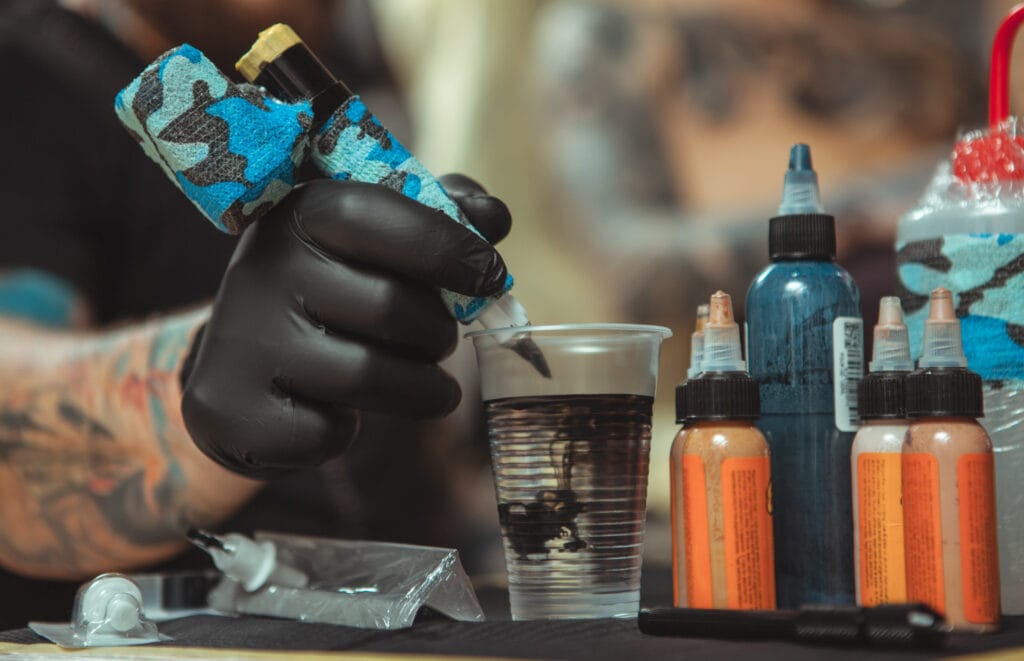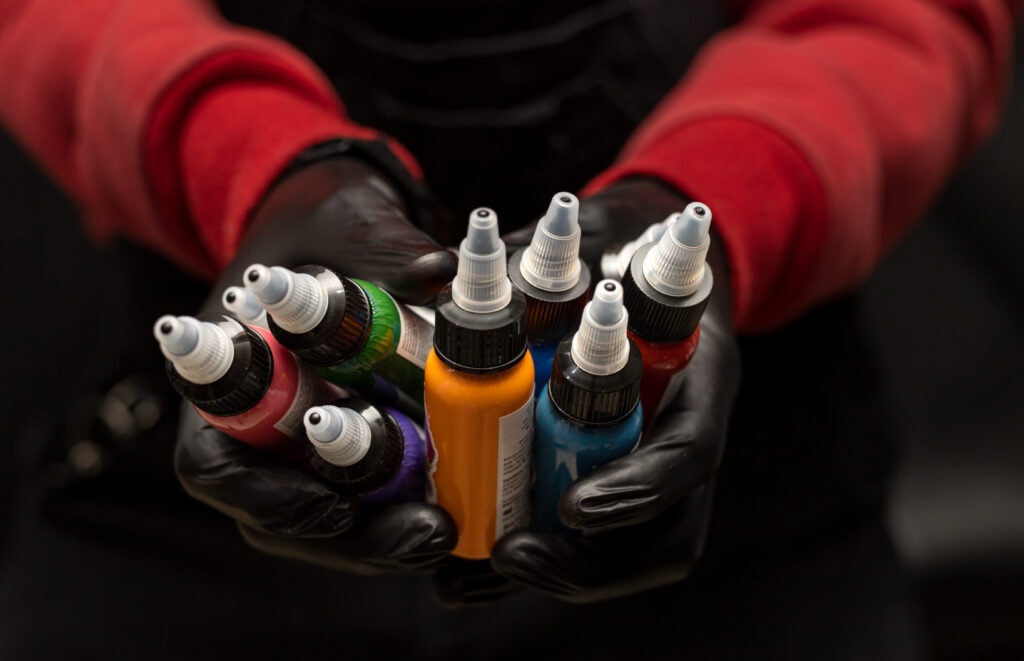For centuries, humans have used the art of tattooing as a form of self-expression. From the tribal markings of ancient cultures to the color-filled masterpieces adorning bodies today, tattoos are a universal language, telling stories that words often cannot.
The indelible art form has seen an upsurge in popularity in recent years, with people of all ages lining up at tattoo parlors to get inked. But how often do we think about the science behind those permanent marks?
More specifically, what is tattoo ink made of? This is a question that even the most seasoned tattoo enthusiasts often can’t answer.
In this blog, we will explore the exciting science of tattoo ink. We will delve into its ingredients, how it’s made, and the safety measures one should consider before getting inked. By the end of this read, you’ll have a better understanding of what goes on behind the needle.
Let’s start by examining the primary component of the art – the tattoo ink.
What is Tattoo Ink Made Of?
To put it simply, tattoo ink is a mixture of pigments and a carrier solution. The carrier solution, which is typically water or alcohol-based, helps the pigment particles to be applied smoothly to the skin and aids in preserving the brightness and longevity of the color.
The pigments, on the other hand, are what give the ink its color. Historically, these pigments were made from natural materials like soot or ash. However, modern tattoo inks often use synthetic pigments, which provide a wider range of colors and greater color stability.
These pigments can be organic or inorganic and can include substances like titanium dioxide (for white), iron oxides (for red, brown, and black), and even exotic materials like the increasingly popular green ink tattoo.
But what’s the process behind creating these vibrant inks? Let’s find out.
How is Tattoo Ink Made?
The process of making tattoo ink involves two primary steps: creating the pigment and mixing it with a carrier solution.
The pigment is usually made by grinding up the raw material into a fine powder, which is then mixed with a liquid to form a paste. This paste is then heated to a high temperature to sterilize it and break down any large particles.
Once the pigment is prepared, it’s combined with a carrier solution to create the ink. The carrier solution not only helps the pigment to be applied evenly, but it also prevents the ink from clumping together and helps to keep it sterile. This mixture is then carefully bottled and sealed to prevent contamination.
Analyzing Tattoo Ink Ingredients

As we’ve already established, tattoo ink is primarily composed of pigments and a carrier solution. However, the specific ingredients can vary greatly depending on the brand and color.
For example, black ink, which is the most commonly used tattoo ink, is traditionally made from soot or carbon black. However, modern black inks often use a synthetic pigment called black iron oxide.
On the other hand, colored inks can contain a variety of pigments. For example, red ink can contain cinnabar, cadmium red, or iron oxide; blue ink can contain cobalt or copper; and green ink can contain chromium oxide or malachite.
It’s also worth noting that some tattoo inks may contain additional ingredients like binders and fillers to improve the ink’s consistency and performance.
Is Tattoo Ink Safe? – Understanding the Risks
When it comes to tattoo ink safety, it’s crucial to be aware of the potential risks involved. While most professional-grade tattoo inks are generally safe, not all inks are created equal. Some tattoo inks can contain harmful substances like heavy metals, which can lead to allergic reactions and other health issues.
Allergic reactions are a common risk associated with tattoo ink, particularly with certain colors like red, green, yellow, and blue. These dyes can cause allergic skin reactions, resulting in an itchy rash at the tattoo site.
Infections are another concern related to tattoo ink. The FDA has received reports of people developing infections from contaminated tattoo inks, as well as allergic reactions to the inks themselves.
Black ink, in particular, can be dangerous due to its high level of benzo(a)pyrene, which is listed as a carcinogen. This makes it a potential risk factor for cancer.
Tattoo inks may also contain polycyclic aromatic hydrocarbons (PAHs), heavy metals, and primary aromatic amines (PAAs), which can pose toxicological risks to human health if present beyond permissible limits.
Furthermore, inaccurate labeling of tattoo ink ingredients is a concern. Studies have shown that ingredient labels are often inaccurate, and some inks even contain nanoscale particles that could harm human cells.
To minimize the risks associated with tattoo ink, it’s important to choose a reputable tattoo artist who uses sterile equipment and follows proper safety procedures. Understanding the potential risks and taking necessary precautions can help ensure a safer tattooing experience.
Choosing Safe Tattoo Ink: What to Look For

When choosing safe tattoo ink, there are several factors to consider.
Firstly, opt for inks labeled as vegan or organic, as they tend to avoid potentially harmful substances like heavy metals.
Secondly, conduct a thorough research by checking the brand, reading reviews, and gathering as much information as possible about the ink’s ingredients.
Lastly, don’t hesitate to ask your tattoo artist for information about the inks they use and their safety profile.
Additionally, consider the following when selecting a safe tattoo ink:
- Safe carriers: Look for inks that use safe carriers like propylene glycol, glycerin, ethyl alcohol, and distilled water.
- Non-toxic pigments: Choose inks with non-toxic pigments to avoid potential health risks associated with heavy metals such as lead, cobalt-nickel, and arsenic.
- Accurate labeling: Ensure that the ink has accurate ingredient labels, as some inks may contain nanoscale particles that could harm human cells.
- Reputable manufacturers: Select tattoo inks from reputable manufacturers who adhere to safety standards and regulations.
Remember to thoroughly research both the ink and the tattoo artist to ensure a safe and enjoyable tattoo experience.
Conclusion: The Science and Safety Behind Tattoo Inks
In conclusion, the world of tattoo ink is a fascinating blend of art and science. From the vibrant pigments to the carrier solutions, there’s a lot more than meets the eye when it comes to what’s behind the needle.
While there are some safety concerns associated with certain tattoo inks, many manufacturers are working towards creating safer, more eco-friendly options. As a consumer, it’s essential to be informed and aware of what’s going into your skin. Remember, a tattoo is a lifelong commitment, and the ink you choose plays a significant role in that commitment.
In the end, tattoos are a beautiful form of self-expression. But understanding what goes into them can help ensure that your body art is not only beautiful but also safe.

